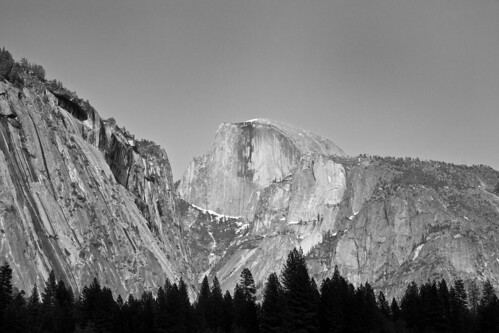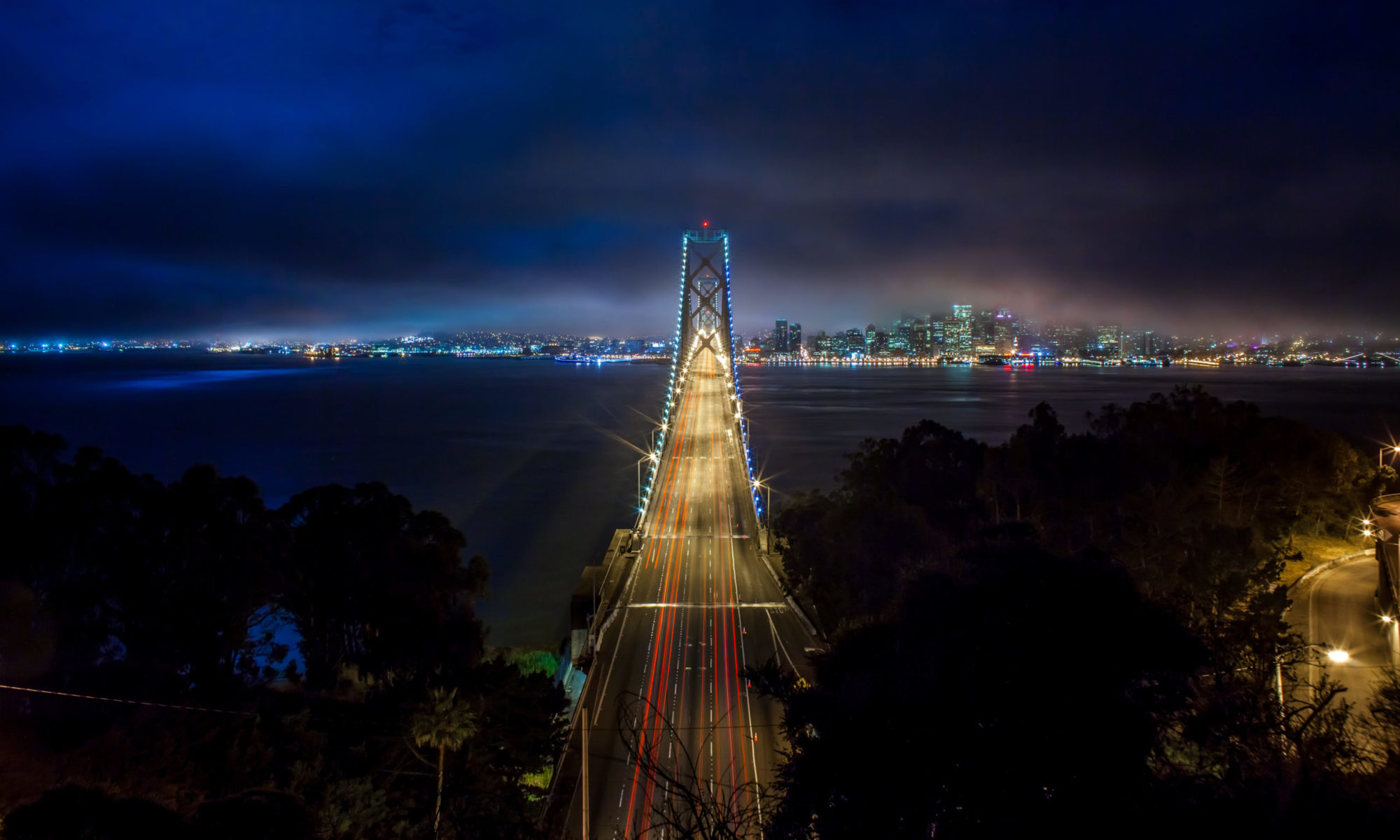
My Ode to Ansel Adams. I took this photograph in the meadow where Ansel Adams shot his famous Moon and Half Dome.
Robert Scoble, Marc Silber, Rocky Barbanica and I had a great opportunity to spend two fantastic days with Michael Adams, Ansel Adams’ son, late last month in Yosemite. We were interviewing Michael for a new video show that Scoble, Silber and myself are working on for FastCompany.TV called PhotoCycle. Rocky is the producer.
During the course of our two days together, Michael took us to many of the historic places where Ansel Adams made some of his most compelling, dramatic enduring and iconic images of nature in Yosemite Valley. During these two days I was able to ask Michael tons of questions about his father and the business that he still runs today selling prints for the Ansel Adams Gallery in Yosemite.
I thought I’d put a post together of 10 interesting things that I learned about one of the world’s most famous photographers from Michael. Please note that these are my impressions based on my conversations with Michael.
1. Ansel Adams would have loved and embraced digital photography. According to Michael, his father very much loved the technology of his day and frequently used the most cutting edge tools available.
We all know about Adams’ revolutionary zone system that he pioneered in the development and printing of photographs. But as much as this, Adams was constantly testing out the very latest and prototype cameras from people like Polaroid and Hasselblad. Because he was Ansel Adams, he had a great opportunity to try out so many new technologies as they rolled out. According to Michael, Haselblad had an understanding with Ansel where pretty much anything they built could be on loan to him.
When I asked Michael how his dad might view digital photography, Photoshop, etc. today, he told me that he thought his dad would love it and very much be involved with it.
2. Ansel Adams proudest moment in his career was probably when he was recognized by the legendary Alfred Stieglitz and given a show at Stieglitz’s prestigious gallery in New York City still early in his career. According to Michael, his father thought the world of Stieglitz and his endorsement with a solo show at Stieglitz’s prestigious gallery in 1936 was probably the thing he was most proudest of, even more than all of his later significant achievements and accomplishments.
3. Ansel Adams typically always had something nice to say about someone else’s photography. According to Michael, even if a particular style or print was not Adams’ taste, he would find something positive about a photograph and compliment the photographer on it. Adams would frequently go out of his way to compliment others on their work and give them positive encouragement and feedback where he could.
4. Sometimes you only have a split second to take a famous photograph. One of my favorite stories that Michael shared with me about his father was when Ansel made perhaps his most famous photograph Moonrise, Hernandez, NM. This photograph is the highest Ansel Adams’ print sold at auction to date having sold at at Sotheby’s for $609,600 in 2006.
According to Michael, Ansel saw this wonderful scene and pulled the car over to take the photograph (Michael was with him). Ansel then put his glass plate into his camera to make his exposure. Before Ansel even had time to pull the plate out and shoot a second exposure on the reverse side, the moment was lost. A one shot opportunity.
5. Ansel Adams still worked for two years in the darkroom after he stopped taking orders for prints near the end of his life. According to Michael, Ansel’s fine art prints were in such demand towards the end of his life that even when he stopped accepting orders from clients for his famous work, he still had a backlog of two years worth of darkroom work to do to fulfill prints that had been previously ordered.
After Adams stopped his darkroom work he was coaxed back into the darkroom for one last project before he died to produce a “museum series” of a select group of his prints that would be used as an entire series and to be shown in museums. I sensed that there was some dissatisfaction over this decision from Michael who seemed to think that this may not have been the best decision for Ansel to make near the end of his life. According to Michael, Ansel died before this series of prints was ever finished.
6. Ansel Adams relied on his commercial work to pursue his passion as a fine arts photographer. Like a lot of photographers in his day, Ansel was not able to earn enough money on his fine art photography alone to devote himself 100% to that life. Michael told me that Ansel frequently took commercial photography assignments (some in color even — in contrast to his more famous black and white work) in order to make a living.
For one of Ansel’s famous commercial assignments for Kodak (which was subsequently printed as a 60ft. x 15ft. billboard sized panoramic advertisement in Grand Central Station) he shot an amazing color-rama with photographers (with Kodak cameras in their hands of course) in it from Washburn point near Glacier Point overlooking Yosemite Valley.
According to Michael, Ansel used a lot of these commercial trips as dual trips where he would shot his commercial assignments in places to also do his fine art photography while he was there.
7. Ansel Adams frequently made duplicate photographs of his images when taking them. One thing that I tell people constantly is that it is always a good idea to take more than one shot of an image if you can in the camera. According to Michael, Ansel frequently took multiple exposures of the same shots. Many of his negatives are duplicate images of which he’d select the best image to use for printing.
8. Ansel Adams was a tireless crusader for conservation. According to Michael one of Ansel’s very first trips to Washington DC was to lobby to make King’s Canyon wilderness a protected area which was accomplished. Michael said his dad went to DC about once a year and was always happy to lobby for these issues.
Ansel was the first photographer to shoot an official Presidential portrait when he was commissioned to photographed President Jimmy Carter. Ansel also met with Presidents Johnson and Ford. One of the interesting stories that Michael told me about his father was when he met with President Reagan. According to Michael they talked for an hour and neither one of them heard what the other one said.
Ansel Adams was awarded the Medal of Freedom by Jimmy Carter in 1980.
9. So much of Adams’ work was in the darkroom. One of the biggest challenges, even today, when images are used from the Ansel Adams archive (at the University of Arizona in Tucson) is to ensure that the final image from the negative is a quality image. So much of the final outcome of Ansel’s work came from the darkroom.
10. The Center for Creative Photography is currently trying to digitize the entire Ansel Adams library. They are scanning his prints and trying to complete the library. Today Corbis represents the commercial rights for the Ansel Adams Publishing Rights Trust which is a trust with three board members who monitor the sales for the benefit of Michael, his sister, and a portion each year which goes to the Center for Creative Photography.
To see some of our early rough video with Michael Adams check out this post by Robert Scoble here. There will be a finished and produced video based on our footage with Michael Adams coming out from FastCompany.TV soon.
Today Michael Adams still operates the Ansel Adams Gallery in Yosemite Valley. Here today they still sell Ansel’s popular work along with many new contemporary photographers. The gallery also has a blog now which you can find here.

What a great experience that must have been! Thanks for the post. It’s interesting to learn that he was a fan of technology, and that he relied on his commercial photography to pursue the photography he is so well known for now.
Ref 3: Ansel Adams typically always had something nice to say about someone else’s photography
I think this was true as long as it was a kind of photography he approved of – Let’s remember the legendary incident when Adams wrote to John Szarkowski at MOMA in disgust at Eggleston’s first exhibit, the first in color in the Museum’s history.
I’m calling bullshit on #3 as well. He did everything in his power to destroy William Mortensen while he lived, and after Mortensen’s death worked hard to prevent his work being archived at the Center for Creative Photography at the University of Arizona.
Hi Thomas,
I’m a new reader to the blog and wanted to thank you for your efforts. Just a quick note on your post… I believe that Steichen’s picture ‘The Pond-Moonlight’ is the most expensive print ever put to market. Reportedly one of his original prints sold for $2.9 million (!) Check this: http://www.popphoto.com/photographynewswire/3912/the-search-for-steichens-29m-pond.html Thanks for the post.
Brian.
Brain,
You are correct in so far as Adams is only number 7 on the top 10 list at the moment – http://en.wikipedia.org/wiki/List_of_most_expensive_photographs
The most expensive photo to date is Andreas Gursky, 99 Cent II Diptychon (2001), $3,346,456, February, 2007. I am actually pleased to see modern photographers taking the lead from the classics for the first time.
I think Thomas was saying that Moonrise was the most expenise Adams print to date.
Yep, I’ve heard these things before. Ansel was a good photographer
Hi Brian and Martin, yes, that’s correct. I meant to say that Adams’ Moonrise, Hernandez, NM print was the highest selling Adams print to date, not necessarily the highest selling print to date.
I adjusted my language in the post to clarify that. Thanks for pointing it out.
Thanks for the post. Fascinating. Can’t wait to see the video.
I sent this link to my uncle, who shared the works of another photographer with me, Clyde Butcher. “He’s known as the Ansel Adams of Florida”. Apologies for taking away from the excellent content of your article, but this is worth sharing.
http://www.clydebutcher.com/online-gallery.cfm
Beautiful!
Excellent post, thanks for all of the good information.
I didn’t even know Ansel had a son until one of your previous posts!
Interesting that you never mention Michael doing photography. Does he not have an interest in taking photos himself?
What a great post. I recently saw the PBS special on Ansel Adams. Thank you for sharing what must have a been a truly wonderful experience.
Great article Thomas!!! Ansel Adams is one of my favorite photographers of all time and has inspired me since I was a kid. Thanks for posting this article about him and his son! I linked this article to my own blog, hope you don’t mind.
Thanks again for posting it!
Is it really necessary to go to these lengths to convince oneself in in the present that an imaginary Ansel Adams In Our Day would embrace digital SLRs? Is it actually so important to people to infer/project this kind of approval for their own efforts? Very odd.
Glass plate?
how did he make this art work
I enjoyed reading this and watching the Marc Silber video immensely!
I especially like the fact that he complimented all photographs. Everyone’s a critic, but it’s a great exercise to find the good in everyone’s work and build upon that.
I really didn’t know how much of his work was done in the darkroom. It makes me appreciate him even more. What an inspiration!